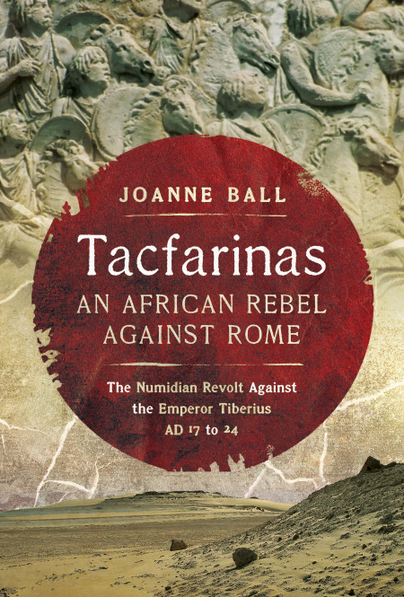Tacfarinas: An African Rebel Against Rome
Author guest post from Joanne Ball.
In the C1st AD, Rome faced unrest and rebellion across the long frontiers of its empire. From the northern provinces of Britain and the Germanies to the near east and Africa, the indigenous populations reached a breaking point while living under Roman rule. Numerous violent uprisings broke out, usually led by a particularly capable or charismatic individual, often someone from the indigenous elite who had been disenfranchised by the arrival of Roman rule. These leaders were able to unite numerous (tribal) factions against Rome as a common enemy – instead of fighting each other, as they previously often did.
Very few of these rebellions were successful – although most did inflict at least one defeat on the Roman army – but some of their leaders have become names of note in history nonetheless, such as Arminius in Germany and Boudica in Britain, two of the best known. Far less familiar is the name of Tacfarinas, a Roman auxiliary deserter-turned-bandit leader-turned rebel commander in northwest Africa – and yet his story, and the conflict he led against Rome, is as fascinating as any uprising from this period.
Tacfarinas served in the Roman army’s auxilia for an unknown number of years before deserting. His desertion would have invited severe punishment – likely death – if he had been recaptured, and it is unclear what led him to take the risk. Although it is unclear how long he stayed in the Roman army, he served for long enough to learn how to train men in Roman style, and may even have been promoted beyond the ordinary ranks. His service also gave him an insider’s view of the Roman army and their operation in the field – including their weaknesses, and how to exploit them amidst the harsh desert conditions of northwest Africa. Such insight had proved invaluable to Arminius in Germany, who had used what he learned during his own service in the auxilia to ambush and nearly annihilate three legions in the Teutoburg Forest in AD 9. Such knowledge was dangerous in the wrong hands, and it is no coincidence that many of the rebel leaders against Rome in the C1st AD had previously served in the Roman army, as had many of their men.
Tacfarinas deserted from Rome at some point between AD 10 and AD 16/17, probably towards the earlier date. At the time, northwest Africa was still recovering from a major revolt in AD 3-6, spearheaded by the Gaetulian tribe – a conflict which Tacfarinas may even have been involved in as a soldier in the Roman army. Although open conflict had temporarily ceased, tensions were simmering under the surface as Rome began to exert its control more openly. There were rumours that land seizures and taxation would soon be imposed on the indigenous population, while the nomadic and semi-nomadic tribes found their freedom of movement increasingly limited. The construction of a road between Ammaedara, the base of the 3rd Legion Augusta, and Tacape on the coast was an especially unwelcome intrusion on the landscape. The region was ripe for another uprising – and Tacfarinas would ultimately end up as the one leading it.
After his desertion, Tacfarinas had initially engaged largely in raiding and banditry against Roman settlements rather than open rebellion – indeed, at this stage, he may have had no intention of leading a large-scale uprising against Rome. He proved a popular leader and drew many young men to fight for him, who hoped to share in the bounty of his raiding. The best of the recruits were drawn off and trained by Tacfarinas personally ‘in the Roman style’, into a skilled and disciplined unit which he hoped could match Rome on the battlefield. The rest became a more traditional raiding force, who instilled fear wherever they turned. Rome initially took no direct action against Tacfarinas, leaving the responsibility instead to King Juba II of Mauretania (modern Morocco), a client king and ally of Rome who was responsible for maintaining security in the region. However, Juba II proved unsuccessful at stopping Tacfarinas – and in AD 17, Rome decided it was time to get directly involved.
No doubt Rome expected defeating Tacfarinas to be easy. Although Juba II had failed, the king’s military resources to take on such a challenge were limited compared to that of the Romans, who could send an entire legion (the 3rd Legion Augusta) into the field, along with probably an equal number of auxiliary units. However, Rome would soon learn how wrong their assumptions were. The ensuing war would last for more than seven years, through the terms of four different proconsuls of Roman Africa (Marcus Furius Camillus, Lucius Apronius, Quintus Junius Blaesus, and Publius Cornelius Dolabella), and require the Roman military force to be doubled in size.
Three times Rome believed the war with Tacfarinas to be over after they inflicted one or more battlefield defeat on him, so much so that the proconsuls involved – Marcus Furius Camillus, Lucius Apronius, and Quintus Junius Blaesus – were granted triumphal honours by Tiberius. In each case, Tacfarinas returned the following year, having made good his manpower losses through new recruits. The defeats clearly had a limited impact on his ability to draw men to his cause, something which no doubt continually confounded Rome. By concentrating his attacks primarily on Roman settlements, Tacfarinas appears to have remained popular with the indigenous population – in contrast to Rome, who likely found few friends among this group.
Tacfarinas used his insider knowledge of the Roman army, and of the landscape of northwest Africa, to his advantage. He deployed largely light-armed troops, who launched lightning-fast raids against both Roman settlements and the Roman army on the march, before disappearing back into the desert or mountains before the lumbering Roman legionaries could react. There are no reliable estimates for the size of Tacfarinas’ army, although it is clear that they substantially outnumbered the Roman force of 10-20,000. Not only was his force large, it was also well-deployed in a way that maximised its strengths while exploiting Roman weaknesses. Tacfarinas’ army avoided pitched battle where they could, especially after being lured into one and suffering a comprehensive defeat, relying instead on guerrilla-type tactics throughout. So effective were these tactics that Rome was ultimately forced to adopt an irregular approach of its own, deploying in a way that was completely different to its usual mode of field operation, including splitting into multiple light-armed divisions, and campaigning year-round.
Although he may have started as little more than a bandit, Tacfarinas did become first a political leader, made chieftain of the Musulamii tribe, and later, a legitimate rebel commander. His campaign of raiding and banditry developed into a regional uprising which drew to his banner many of the indigenous tribes who hoped to free themselves of Roman rule. Tacfarinas’ position as a tribal chieftain led him at one point to try and negotiate a peace settlement directly with the emperor Tiberius, provoking extreme Imperial rage at his audacity; in the event of a refusal, Tacfarinas had promised war without end. He inspired his men to believe that Rome could be forced to abandon conquests by referencing the recent Roman withdrawal from the German territories east of the Rhine, a decision prompted by Arminius’ uprising. The threat to Roman interests in northwest Africa were very real at this point.
However, Tacfarinas did not bring any long-term change to the region. In AD 24, with the conflict raging on, intelligence reached Publius Cornelius Dolabella, the fourth proconsul of Africa to face Tacfarinas, that the rebel army was encamped near a ruined fort named Auzea, previously occupied by a Roman unit. Dolabella dispatched an army to the site, and launched an dawn attack on Tacfarinas’ army, who were completely unprepared for the attack. The ensuing battle was brutal, with Roman soldiers taking revenge in blood for the hard years of conflict they had suffered through due to Tacfarinas; no surrenders were accepted nor prisoners taken. Tacfarinas chose to die on the battlefield rather than fall into Roman custody, hurling himself onto Roman blades when he found himself surrounded with no chance of escape. In doing so, he spared himself some unpleasant likely consequences of capture, which would have included humiliation and public display, torture, and ultimately, execution.
Rome never again faced such opposition in northwest Africa, which over time became one of the more pacified regions of the empire. No one individual was ever able to unite the anti-Roman faction in the way that Tacfarinas had, nor to deploy his men so effectively against the Roman empire. Although he is not as well known as some other rebels against Rome, Tacfarinas made an indelible mark on the history of the early Roman empire.

Order your copy here.

